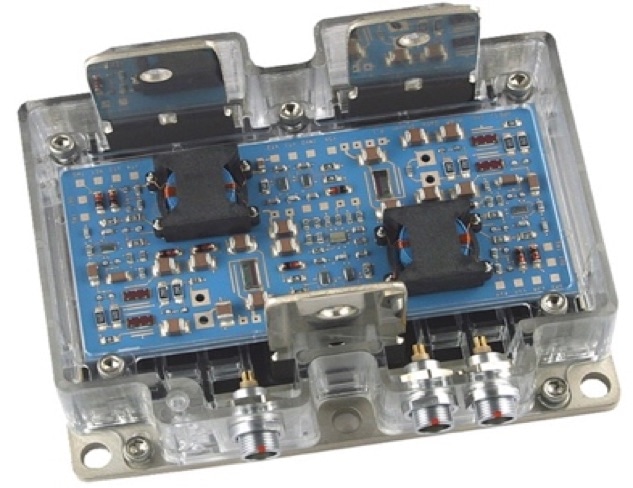Sep 12 2016
The U.S. Department of Energy awarded $599,901 to University of Arkansas engineering researchers to continue developing an “optocoupler” – a packaged light emitter and detector – to improve the performance of electric vehicles.
 The researchers will install and test high-temperature optocouplers on this power module developed by at the University of Arkansas' High Density Electronics Center. Photo courtesy of Zhong Chen.
The researchers will install and test high-temperature optocouplers on this power module developed by at the University of Arkansas' High Density Electronics Center. Photo courtesy of Zhong Chen.
When integrated into high-density power modules, the technology will lead to superior performance in terms of power density, energy efficiency and thermal management.
Unreliable and inefficient power modules are a major obstacle to the further development of electric vehicles. Current semiconductor materials and optoelectronic devices in power modules struggle when engine heat is higher than 125 degrees Celsius or lower than –55 degrees Celsius. Under these conditions, power modules lose efficiency and function poorly, making the motor less reliable.
“It isn’t the intrinsic properties of power devices themselves that prevent their use at higher temperatures, but rather the low-voltage electronics needed to drive them and the packaging that surrounds them,” said Zhong Chen, assistant professor of electrical engineering and lead researcher on the project.
Compared to conventional power modules, which require a comprehensive thermal-management system, high-density power modules not only enhance reliability but also significantly reduce cooling requirements. An optocoupler uses light waves to provide high voltage and transient noise isolation. The advantages of using optocouplers include significant size reduction, higher voltage isolation and superior electromagnetic interference immunity, among others.
Chen and colleagues Fisher Yu, associate professor of electrical engineering and Alan Mantooth, Distinquished Professor of electrical engineering, will integrate the optocoupler with a high-density power module built by Mantooth and researchers at the university’s High Density Electronics Center.
Typical operating temperature for optocouplers is less than 100 degrees Celsius, or 212 degree Fahrenheit. To determine what mechanisms cause them to fail at high temperatures, Chen will design and characterize the performance of LEDs and detectors at temperatures up to 400 degrees Celsius. The goal is to develop and test an optocoupler that can operate continuously and reliably at 250 degrees Celsius.
Mantooth holds the Twenty-First Century Research Leadership Chair in the College of Engineering.